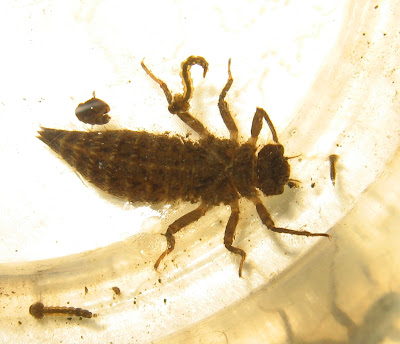A common denizen of forested areas with rich, moist soil, the gracefully arching fronds of the Ostrich Fern typically grow in circular groups. Since this showy fern makes a desirable subject for shady areas of gardens it's easy to find some growing closer to home, for example, along the front porch of the Tweed Heritage Center.
Wednesday, August 21, 2013
Ostrich Fern (Matteuccia struthiopteris)
Tuesday, August 20, 2013
Psychedelic Cecropia Moth Caterpillar
Maybe this is the Hookah-Smoking Caterpillar that Alice was talking to on her journey to Wonderland?
In terms of both wingspan and sheer bulk the Cecropia Moth is the largest of the local Saturniid or Giant Silk Moths. But then, Hyalophora cecropia starts out life as a larval heavyweight.
Tuesday, August 13, 2013
To see a World in a sample of Pond Scum
The strange and weird things one learns from the most mundane circumstances.
The green growths on a stone fished out of the Moira River are colonies of – I'm still not entirely clear which – either a blue-green cyanobacterium called Nostoc parmelioides, or an algae composed of the bacteria.
This organism is symbiotic with a tiny species of midge called Cricotopus nostocicola, the larvae of which develop in the algae, changing its form from small round growths to a semi-circular shapes; both versions can be seen in this picture. The Cricotopus larvae are supposed to be visible within the semi-circular colonies – how large are they, and is my camera's macro good enough to capture an image?
Blue-green algae or cyanobacteria ... other than that I have no idea what this stuff is, or even if it's all the same species. Sometimes it's found growing in tangled masses of filaments, or it may be organized in lacy branches.
Reality Bites
This isn't the kind of photography everyone might appreciate, but it's the reality of the world of nature. Predation and parasitism are an integral part of the story of life and have been going on for millions of years, nor are we exempt from the cycle.
I've never seen anything like this! I've heard of large Bullfrogs eating small snakes and have seen them dispatch smaller frogs, including cannibalizing their own kind, but this is the only instance I've observed one eating a bird.
The fledgling flew into – or too close – to the water, and the Bullfrog had caught it headfirst and was sculling backwards with its webbed feet, dragging the bird underwater and drowning it like a crocodile would an antelope. And this wasn't a particularly large frog, only about four inches long.
An Instance of Mistaken Identity
Stream Bluet (Enallagma exsulans), female – this specimen was so aberrantly marked and colored compared to the norm for this area that I mistook it for a female Double-striped Bluet. The postocular spots are very small, the paler stripes within the middorsal carina and humeral stripe are quite pronounced, and the "W" on S9 is relatively elongated.
Alhough it would have been exciting to have stumbled upon another odonate species outside of its historical range, I would never in any event accept this as a Double-striped Bluet sighting without checking the mesostigmal plates or seeing and/or photographing a male or a mating pair.
Friday, August 9, 2013
Spiketail Naiads
Found buried in a sand-bottomed stream flowing through a wooded area, 25 mm in length, it's definitely Cordulegaster spp. – but which one?
There are three members the family Cordulegastridae in our area: the Delta-spotted Spiketail (Cordulegaster diastatops), the Twin-spotted Spiketail (Cordulegaster maculata), and the Arrowhead Spiketail (Cordulegaster obliqua). According to the Ontario Odonata Summary Atlas the Arrowhead Spiketail is by all accounts an uncommon dragonfly and it's tempting to rule it out on this basis. But by the same token the naiad was encountered in appropriate habitat within half a kilometer of where an adult female Cordulegaster obliqua was sighted and photographed in mid-June of 2011.
Where there's one Spiketail naiad it's reasonable to expect there might be others, so it looks like more forays to the woodland stream in the near future to acquire a larger, older instar to study.
If they survive that long, three of these will emerge and transform into adults next year, and one, the first of today's finds, will not, as it was dead when I came upon it. Bad luck for the naiad, but this gave me an opportunity to photograph the prementum and palps on a relatively large specimen. Here are the images in the order they were acquired, and it's only fair to point out that this isn't really good science, as the characteristics we're looking at in the following images are not attributes of the same individual.
So it's still a bit of an open question because of inconsistencies in the number of palpal setae, but for now the weight of the evidence points toward the Twin-spotted Spiketail (Cordulegaster maculata). Despite the numbers of larvae, and although this species does range in this area, I have never encounterd it in its adult incarnation. But next summer I will certainly be staking out this stream when the Twin-spotted Spiketails are expected to emerge and fly in early June.































































